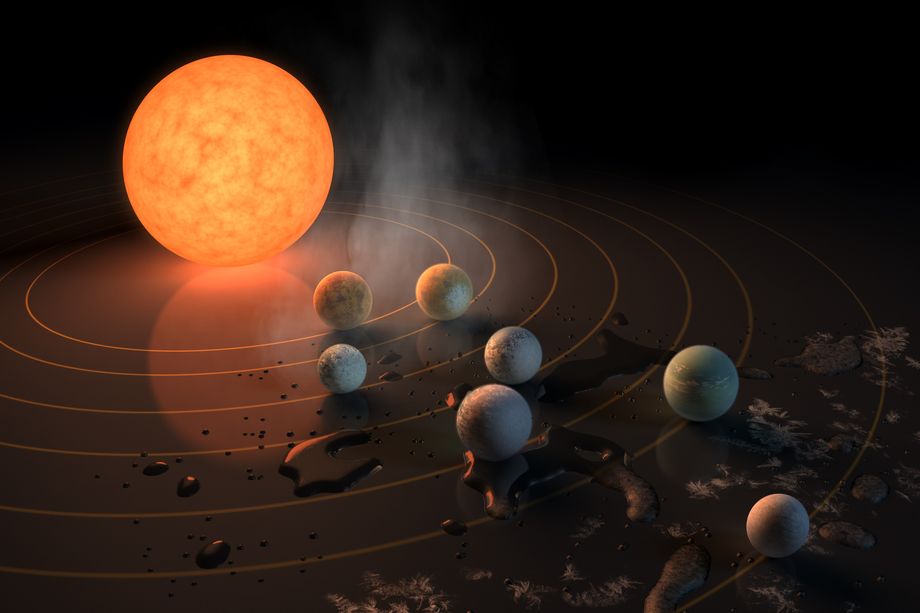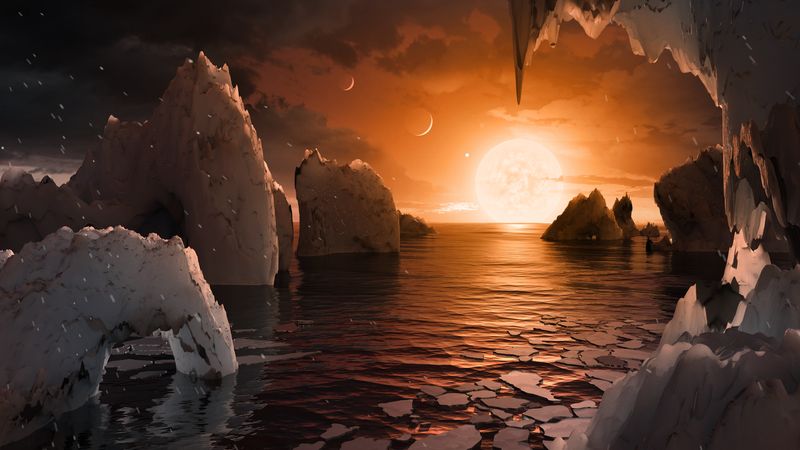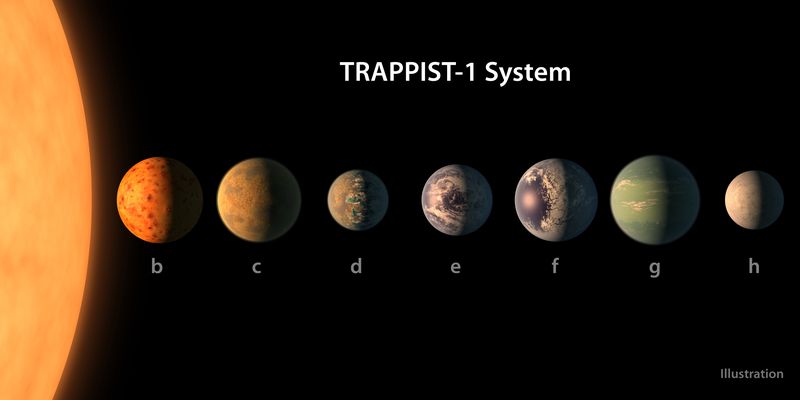What is the importance of NASA discovery of the star system TRAPPIST-1

Yesterday on Geektimes news about a new discovery of NASA was published : a star system with several earth-like planets. It is located not so far from us: only 40 light years. The existing technologies of space flight still do not allow man to reach an object located at this distance from the Earth. But to study this star system is still easier than most other star systems with exoplanets discovered by scientists, most of which are located hundreds of, if not thousands, of light years from our solar system.
In total, there are seven planets in this star system, three of them are located in the zone where the existence of water in liquid form is possible. The rest of the TRAPPIST-1 planets are too far away or too close to their star. Accordingly, they either represent cold worlds covered with ice, or these planets are too hot for the existence of water in liquid form. Now there is more data on the TRAPPIST-1 system, so you can already better understand what we are facing.
So, the fact that the cold and dim red dwarf with catalog number 2MASS J23062928-0502285 has a planetary system, scientists did not know yesterday. This became known in May 2016 thanks to a joint team of astronomers from Belgium and the United States. The discovery was made using the TRAPPIST robotic 0.6 meter telescope (TRAnsiting Planets and PlanetesImals Small Telescope), located at the ESO La Silla Observatory in Chile. Three of the seven planets were discovered by the transit method, that is, they were discovered when the planets passed through the star's disk. By the depth of the eclipse, you can determine the size of the planet that passes on the disk, which was done.
')

Perhaps this is what the surface of the planet TRAPPIST-1f looks like. Source: NASA
| Planet | Weight ( M ⊕ ) | Radius ( R ⊕ ) | Period of treatment (days) | Big axis orbits (a. e) | Eccentricity orbits | Insolation ( I ) |
|---|---|---|---|---|---|---|
| b | 0.85 ± 0.72 | 1,086 ± 0,035 | 1,51087081 ± 0,00000060 | 0,01111 ± 0,00034 | <0.081 | |
| c | 1.38 ± 0.61 | 1.056 ± 0.035 | 2.4218233 ± 0.0000017 | 0.01521 ± 0.00047 | <0.083 | |
| d | 0.41 ± 0.27 | 0.772 ± 0.030 | 4,049610 ± 0,000063 | 0.02144 ± 0.00065 | <0.070 | |
| e | 0.62 ± 0.58 | 0.918 ± 0.039 | 6.099615 ± 0.000011 | 0,02817 ± 0,00085 | <0.085 | |
| f | 0.68 ± 0.18 | 1,045 ± 0,038 | 9.206690 ± 0.000015 | 0.0371 ± 0.0011 | <0.063 | |
| g | 1.34 ± 0.88 | 1,127 ± 0,041 | 12,35294 ± 0,00012 | 0.0451 ± 0.0014 | <0.061 | |
| h | - | 0.755 ± 0.034 | ~ 20 | ~ 0.063 |
Details of the discovery of the planets in the system TRAPPIST-1
In 2016, scientists who discovered this star, observed several darkening of its disk. These periodic phenomena were explained by the passage over the disk of the planets, which at this moment are between their star and the observer from Earth. After astronomers told about what they saw, they received the right to use the time of the NASA Spitzer telescope during the entire second half of 2016. Scientists have decided to continuously monitor the open system for 20 days. Spitzer and other ground-based telescopes allowed specialists to study 34 darkening of the star's disk - this is even more than the astronomers initially counted on.

After a thorough analysis, it was concluded that the red dwarf TRAPPIST-1 immediately had seven terrestrial planets, which is currently a record. Other star systems with so many terrestrial planets until scientists have seen. The planets received the TRAPPIST 1 b, c, d, e, f, g, and h designations. Further study of the passage points of exoplanets over the star's disk helped to clarify the dimensions, characteristics of the orbits and the masses of the planets in this system. Also, scientists have received information about the gravitational influence of the planets on each other.
What did you learn about the star TRAPPIST and its planets
The star TRAPPIST-1 is a red dwarf. Its mass is only 8% of the mass of our luminary, so that it is only slightly larger than Jupiter. By the way, red dwarfs are quite common in our galaxy, and make up 15% of the total number of stars in the Milky Way. Planet stars are "packed" quite tightly. The planet TRAPPIST 1 most distant from its star - h rotates at a distance of 0.06 AU, the closest one - at a distance of 0.01 AE. The planets of the solar system are distributed more evenly and are much farther from the sun. For example, Mercury is located at a distance of 0.39 AE, and this is the closest planet to the star in our system. Of course, TRAPPIST 1 cannot be compared with the Solar System, but this fact is remarkable.
Probably, the planets were formed about 500 million years ago with their star. All seven planets move in circular orbits in one direction.
The size of the planets b, c, e, f, g is comparable to the size of the Earth . Planets d, h are similar in characteristics to Mars. All seven planets are stone, there are no gas giants in this system.
Based on how much these planets receive energy from their star, it can be assumed that on the surface of three of them (e, f, g) water may exist in liquid form.
There is another important point. The star TRAPPIST 1 emits as much ultraviolet and x-rays as the sun. At the same time, as we remember, the planets in this system are much closer to their star than the planets of the solar system. This means that they constantly receive a huge dose of these types of radiation. Scientists assume that all seven planets are constantly turned to their own luminary by one side, which reduces the likelihood of life.
What remains unknown?
In general, there is still much to learn about this system. Now, unfortunately, scientists can only assume many things. No one knows if there is liquid water (rivers, seas, oceans) on the surface of one or more planets in the TRAPPIST 1 system. It may not be. For example, Venus and Mars are at such a distance from the Sun when there is the possibility of the existence of liquid water on the surface. But, as we know, neither on Mars, nor, especially, on Venus there are no reservoirs with liquid water.
Moreover, it is unknown whether there is life. It is possible to assume its existence, but this is not at all necessary. Unfortunately, man has not yet found life on other planets, even within his own solar system, not to mention exoplanets.
Why is it important?
After NASA announced an extraordinary press conference, a lot of rumors appeared on the network, including speculations about finding life on one of the exoplanets or the planets of the solar system. After the agency’s experts told “only” that almost next to us there are seven earth-like planets, many people, those who followed the news from NASA, were disappointed.
In fact, the discovery is extremely important. The fact is that the TRAPPIST 1 system is ideal for studying the origin and evolution of earth-like planets. Observation of these exoplanets will help to find out why the Earth, Mars and Venus began to develop in equal conditions, and then began to differ sharply from each other.
“This is the Rosetta Stone , on which there is information at once in seven different languages - these are seven different planets that can give us interesting information regarding the formation of such objects,” says one of the research participants.
In addition, the study of worlds like ours, can lead to the discovery of extraterrestrial life. Yes, so far this has not happened, but anything is possible in the future. If a person does find life on other planets, it will significantly expand the current picture of the world.
One of the NASA employees, Robert Frost, suggests comparing the significance of the possible discovery of extraterrestrial life with the release of a certain tribe that has lived somewhere in isolation in caves and other lands for thousands of years. Here this tribe sees the bird for the first time and understands that the forms of life may be quite different than those they have seen so far. Then the tribe sees the fish, realizing that there is life that lives in the water. All this can change the attitude of the world and the world perception of the tribe, leading to dramatic changes in its development.
The same can be said about our modern civilization. We only know about life, the basis of which is carbon. The forms of this life are simply enormous, but carbon, if I may say so, is the basis of everything. On other planets, man is looking, first of all, for carbon life and manifestations of the vital activity of carbon organisms.
Modern discoveries of scientists suggest that the Earth is not a unique planet. There are other planets that are very similar to her. On their surface may be warm seas or oceans, there is carbon, which means that there may be carbon life. Like it or not - remains to be seen. But the probability is not zero at all.
The study of other stellar systems, the detection of exoplanets gives scientists another important opportunity - clarifying the Drake formula .

Where:
- the number of intelligent civilizations ready to make contact;
- the number of stars formed per year in our galaxy;
- the proportion of stars with planets;
- The average number of planets (and satellites) with suitable conditions for the emergence of civilization;
- the probability of the origin of life on a planet with suitable conditions;
- the probability of occurrence of rational life forms on a planet on which there is life;
- the ratio of the number of planets, reasonable inhabitants of which are capable of contact and are looking for it, to the number of planets on which there is intelligent life;
- the lifetime of such a civilization (that is, the time during which a civilization exists, is able to make contact and wants to make contact).
The more other systems and planets in these systems a person will discover, the more accurate the calculations will be by the formula. And the higher can be a person’s confidence that we are not alone in the Universe, somewhere there are other planets inhabited by living organisms. What kind of organisms they can be - we do not know, but the discovery of the star system TRAPPIST-1 by NASA will help to find out. It may well be that this and other discoveries will radically affect the development of various branches of science and our vision of ourselves in the Universe.
Now scientists continue to study the detected exoplanets. In particular, experts are trying to determine the presence of individual components of the atmosphere of the planets. One way to do this is to analyze the radiation spectrum when a planet passes over its star disk. If the spectral analysis shows the presence of a significant amount of water in the atmosphere, it will allow to speak about the possibility of the existence of lakes, rivers and seas on the surface of such a planet. The next step is the definition of elements and chemical compounds that can serve as indirect evidence of the existence of life. This may be, for example, oxygen. “Without life on Earth, we would have no oxygen at all. Therefore, we need to determine which substances to search for, ”says one of the research participants.
Helping scientists find answers to these questions will help, in particular, the telescope "James Webb . " After launch, he will be able to track a huge number of star systems and planets of these systems. Unfortunately, it is planned to launch it only in a year. And then NASA will be able to clarify some of the characteristics of TRAPPIST-1 and the planets orbiting this small star.
Source: https://habr.com/ru/post/401831/
All Articles